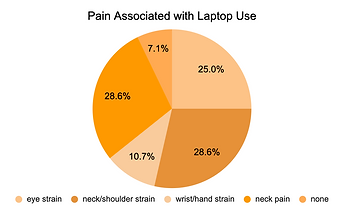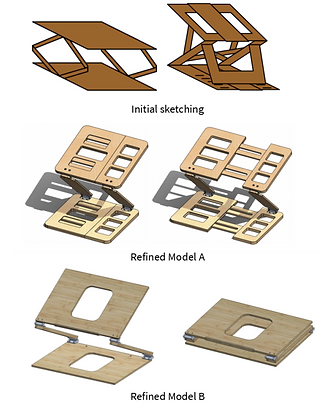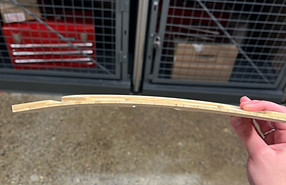Senior Capstone
Environmentally Friendly Laptop Stand
Advisor: Dr. Rouzbeh Amini
Members: Nina Bellusci, Maeve Gaus, Sara Kamboj, Rebecca Tesylar, Aidan Winter
Problem
-
With screen time and laptop usage at a high, it is inevitable that most individuals develop various health related issues
-
Most laptop stands on the market are made with materials which cannot be recycled or biodegraded
-
Laptop stands tend to be too expensive, poorly engineered and not portable

Process
Stage 1: Research
-
Market research: The team assessed the most popular stands on the market to assess what gaps needed to be filled.
-
Materials analysis: Material needed to be lightweight, strong and cost effective. Bamboo was finally chosen.
Stage 2: Design
-
Several phases of sketching were conducted and two final CAD models (A and B) were down selected.
-
Model A was designed for adjustability of the angle, height, and width of the stand. Additionally, material cutouts were added to reduce weight and prevent overheating. The components were designed to reduce the total number of unique parts needed.
-
Model B, was designed for its ease of manufacturability. It is also adjustable in height and angle.
Stage 3: Prototyping
-
The stands were laser cut and 3D printed to test and refine various mechanisms.
Stage 4: Manufacturing final models
-
Both models were manufactured using bamboo with a CNC router


3D printed and laser cut parts
Troubleshooting
-
The main issue was that once the CNC machined parts were returned, the parts were severely warped. This was potentially due to a variety of environmental changes on the bamboo.
-
In order to combat this, the parts were soaked in water, then clamped to a flat surface and left to dry. This significantly improved the parts.
-
Furthermore, in the design stages, one of the main issues the group had the addressed was to ensure that the stand retains its portability and lightness but simultaneously, has enough support to withstand the weight of a laptop and a user typing.

Analysis and Final Result
-
Static structural Finite Element Analysis (FEA) was conducted on the stand to simulate consumer use and understand where stress concentrations/weakest points were
-
An eco-analysis was conducted on our design (Model A) vs market competitors. Our design proved far more eco-conscious than others.
-
A Usability Study was also performed by various students in order to obtain data on how the stand actually felt to use. It was well received!
-
Lastly, the final prototype was presented, displayed and given to our advisor for his personal use.


